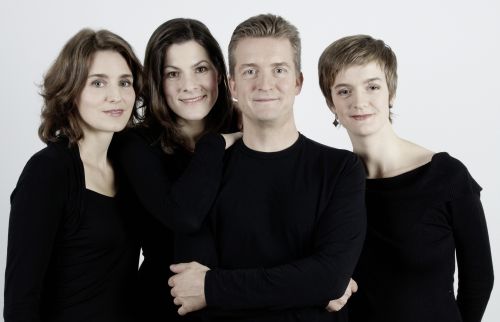 United States Haydn, Bartók, Beethoven: Tetzlaff Quartet, Christian Tetzlaff (violin), Elisabeth Kufferath (violin), Hanna Weinmeister (viola), Tanja Tetzlaff (cello), Zankel Hall at Carnegie Hall, New York 24.10.2013 (SSM)
United States Haydn, Bartók, Beethoven: Tetzlaff Quartet, Christian Tetzlaff (violin), Elisabeth Kufferath (violin), Hanna Weinmeister (viola), Tanja Tetzlaff (cello), Zankel Hall at Carnegie Hall, New York 24.10.2013 (SSM)
Haydn: String Quartet in C major, Op. 20, No. 2
Bartok: String Quarter No. 4
Beethoven: String Quartet in A minor, Op. 132
Christian Tetzlaff’s schedule for November takes him to thirteen venues as far apart as Hamburg, Philadelphia and Helsinki to perform fifteen concerts. How he has the time to be part of a quartet is as much a wonder as is the exceptional quality of the quartet itself. There is no shortcut to the kind of performance the Tetzlaff Quartet gave here; no way that any group could achieve the results it did without a considerable amount of rehearsal time and practice. The sheer rapport, trust and confidence that they radiated was palpable, and it resulted in music that was refined, polished and precise without the slightest bit of flashiness or showiness. Their attention to detail never interfered with the overall conceptual lines that governed each movement. This was playing on the highest level where each note carried the weight of authority.
There are few musicians who can be convincing enough to challenge a great composer’s urtext. Glen Gould was one such genius, ignoring the historical assumptions about both Bach’s music and Bach’s likely interpretive style. He drew some contrapuntal lines out and hid others in seemingly arbitrary ways. Tempi were exaggeratedly fast or exceedingly slow. Legato lines were often played détaché. Yet it worked. He certainly took the starch out of the Cantor’s collar and maybe was playing Bach the way Bach himself might have played his music.
I say this because there was much interpretative freedom in the Tetzlaffs Quartet’s playing. The opening Haydn Moderato was anything but moderate. This completely changed the character of the piece, taking it out of the somewhat lethargic world of many Haydn middle-period works and giving it the feel of later masterpieces such as the “Prussian” Quartets and those from the Opus 70s. How fast was it? The reputable Kodály Quartet slogs through the first movement in about ten minutes, the Tetzlaff in under seven. A lovely Adagio followed with its haunting theme played by the cello and its momentarily dramatic bursts of recitatives. Without stop the group went straight into the minuet, a piece that mixes a droning imitation of his patron’s favored instrument, the baryton, with sudden modulations into the minor key. The fugal last movement ends with a coda sped up yet so convincing it belies the fact that although Haydn did not mark the coda accelerando, one wishes that he had.
The Tetzlaff played Bartók’s Quartet No. 4 with equal mastery. With no specific connection between this quartet and the Haydn, the group performed it as if it were a natural progression from Haydn to Bartók. The same adjectives of refinement, precision and polish could be applied to all three works on the program. The Tetzlaff group could be faulted for not bringing out the romantic Hungarian folk motifs that always vie with the more modern, analytical elements in the quartets, choosing instead to capture the work’s anxiety, edginess and taut frenetic energy; but it’s hard to criticize something that works. In contrast to Haydn’s lack of instructions on how to end his quartet, Bartók specifically sets up his coda with quick tempo changes from Piu vivo to Meno mosso, hammering home the final two measures by marking them Pesante. The brief second movement is a buzzy Prestissimo played con sordino, mixing pizzicati with glissandos and sul ponticelli (played as close to the bridge as possible). The third movement is a study in contrast, both agitated (agitato) and tranquil (tranquillo). The final two movements are a guided tour of string techniques: pizzicato to be plucked so hard that it bounces off the finger-board; glissandi (sliding) and col legno (strings played with the wood part of the bow). The Tetzlaff Quartet managed all these difficulties with authority, aplomb and humor (at one point hitting the music stands with their bows).
Beethoven’s monumental Quartet Op. 132 is a rollercoaster of emotions, its five movements held in place by the third movement, the longest one in all of his quartets. The Tetzlaff performance was hypnotic, with the third movement designated as Heilige Dankgesang (“Holy Song of Thanksgiving”). It was so sublimely and prayerfully played that it bordered on silence; so soft that the muffled sound of the subway, generally not noticeable, here seemed like a sacrilege. When the players finished this movement, they held their bows up for the longest time that I can remember. For both the Quartet and the audience, it was a needed moment to recover from this ethereal interlude, before continuing with the sharply contrasting final two movements.
Loud applause had the Tetzlaffs returning to the stage to play the Minuet from the third movement of Haydn’s Quartet No. 3 from the Op. 20 set.
Stan Metzger
